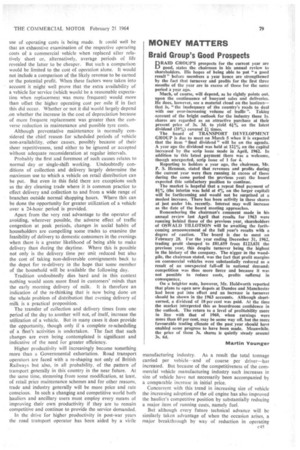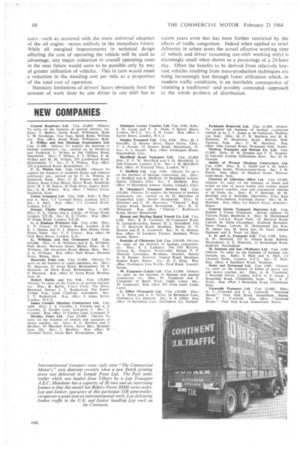Not on Service
Page 80

Page 81

Page 82

If you've noticed an error in this article please click here to report it so we can fix it.
S. BUCKLEY, Assoc. INST. T.
GIVES ADVICE ON TRANSPORT PROBLEMS
BECAUSE operating costs are a basic subject of this series it is natural that they should be examined in detail regularly. Nevertheless, despite the importance of the subject, it is not an end in itself. The ultimate objective is the provision of a transport service that proves satisfactory to both provider and user.
Particularly when the provider is a haulier risking his own capital, it is essential that he should have a reliable yardstick, such as accurate operating costs, so that he can make a reasonable estimate as to the profitability of his intended service.
However, a difficulty arises here when making such estimates. As will be seen in "The Commercial Motor Tables of Operating Costs ", different castings are shown
for varying groups of average weekly mileages. It follows, therefore, that until the likely average weekly (or yearly) mileage is known—at least approximately—an accurate forecast of the operating costs cannottbe made. In this respect the newcomer is in a particularly difficult situation when trying to forecast his average mileages unless he is in the fortunate position of having been guaranteed virtually full employment for a long period.
It is in just such a dilemma that the realistic use of operating costs is essential. Thus, to quote a typical example, the recommended minimum charge per mile for a 7-ton goods vehicle fitted with oil engine is, as shown in "The Tables ", 43-93d. when averaging only 200 miles a week. But it is less than half this amount 20.55d. a mile ----when the same vehicle averages 800 miles a week. Incidentally, the higher average weekly mileage would be much nearer a normal week's work for this type of vehicle than the lower figure. That being so, the prevailing charge in a competitive market would be more likely to be the lower of these two figures.
When making just such a comparison it will be realized that the term "cut rate" when wrongly used can be misleading. In theory, at least, if two competing hauliers did in fact work ht the rates quoted for the average weekly mileage given, then both would have made the identical margin of profit—namely, 20 per cent.
Additional Financial Resources When setting up in business, therefore, it must normally be excepted that the new haulier's vehicle will be less fully employed than those of his well-established competitors. If he is, nevertheless, to be in a position to quote competitive rates to prospective customers, then he must have additional financial resources over and above what is necessary to provide yehicles and other essential equipment to stem him over the interim period—admittedly an unprofitable one—when he is establishing himself.
Unfortunately, entry into haulage is sometimes made without such reserves. The adverse results of such a policy are, however, not necessarily felt immediately. Particularly when a new vehicle has been obtained by the use of some form of credit finance, the actual outgoings (as opposed to the total operating costs which will ultimately have to be met) are relatively small, and so could mislead a newcomer into believing that he was genuinely competitive with those hauliers able to use their vehicles to a greater extent. The accumulation of major repairs, tyre replacement and eventually vehicle replacement, would dispel that erroneous opinion.
Under-employment of Vehicles Although the difficulty arising from under-employment of vehicles is probably greatest for the newcomer, it is nevertheless a continuous problem with which even the established haulier is always grappline.
Periods when vehicles are not on service can be divided as between scheduled and unscheduled, whilst the reasons for their non-availability are either of engineering or traffic origin.
Scheduled periods of non-availability are normally associated with servicing and other work as determined by the particular preventive maintenance scheme selected. Briefly, the protagonists of such schemes contend that the decision to be made is not between vehicles available or not available for service—rather is it between vehicles not available for service at known rather than unknown times. In this context, in view of recent doubts on the value of preventive maintenance, it should be added that the question as to whether any particular preventive maintenance scheme is over generous is another issue and does not necessarily invalidate the principle of preventive maintenance.
Maximum availability for service is the underlying thinking in the growing policy of more frequent vehicle replacement. Here again in appropriate circumstances the right use of operating costs is being made. It could well be that an exhaustive examination of the respective operating costs of a commercial vehicle when replaced after relatively short or, alternatively, average periods of life revealed the latter to be cheaper. But such a comparison would be limited to the cost of operation alone. It would not include a comparison of the likely revenue to be earned or the potential profit. When these factors were taken into account it might well prove that the extra availability of a vehicle for service (which would be a reasonable expectation when replacement was more frequent) would more than offset the higher operating cost per mile if in fact this did occur. Whether or not it did would largely depend .on whether the increase in the cost of depreciation because of more frequent replacement was greater than the converse reduction in maintenance and possible tyre costs.
Although preventative maintenance is normally considered the chief reason for scheduled periods of vehicle non-availability, other causes, possibly because of their sheer repetitiveness, tend either to be ignored or accepted without adequate reconsideration at regular intervals.
Probably the first and foremost of such causes relates to normal day or single-shift working. Undoubtedly conditions of collection and delivery largely determine the maximum use to which a vehicle on retail distribution can be put. But even in this field there are exceptions such as the dry cleaning trade where it is common practice to effect delivery and collection to and from a wide range of branches outside normal shopping hours. Where this can be done the opportunity for greater utilization of a vehicle over a 24-hour period is provided.
Apart from the very real advantage to the operator of avoiding, wherever possible, the adverse effect of traffic congestion at peak periods, changes in social habits of householders are compelling some trades to examine the feasibility of delivery to domestic consumers it) the evenings when there is a greater likelihood of being able to make delivery than during the daytime. Where this is possible not only is the delivery time per unit reduced but also the cost of taking non-deliverable consignments back to the depot for re-delivery in the hope that some member of the household will be available the following day.
Tradition undoubtedly dies hard and in this context nothing would seem more fixed in customers' minds than the early morning delivery of milk. It is therefore an indication of the re-thinking that is now being done on the whole problem of distribution that evening delivery of milk is a practical proposition.
The transfer of collection and delivery times from one period of the day to another will not, of itself, increase the utilization of a vehicle. But in many cases it does provide the opportunity, though only if a complete re-scheduling of a fleet's activities is undertaken. The fact that such changes are even being contemplated is significant and indicative of the need for greater efficiency.
Higher productivity will increasingly become something more than a Governmental exhortation. Road transport operators are faced with a re-shaping not only of British Railways but also, in all probability, of the pattern of transport generally in this country in the near future. At the same time, stemming from some modification, at least, of retail price maintenance schemes and for other reasons, trade and industry generally will be more price and rate conscious. In such a changing and competitive world both hauliers and ancillary users must employ every means of improving their own productivity if they are to remain competitive and continue to provide the service demanded.
In the drive for higher productivity in post-war years the road transport operator has been aided by a virile manufacturing industry. As a result the total tonnage carried per vehicle---and of course per driver—has increased. But because of the competitiveness of the commercial vehicle manufacturing industry such increases in size of vehicle have not necessarily been accompanied by a comparable increase in initial price.
Concurrent with this trend in increasing size of vehicle the increasing adoption of the oil engine has also improved the haulier's competitive position by substantially reducing a major item of running costs, namely fuel.
But although every future technical advance will be similarly taken advantage of when the occasion arises, a major breakthrough by way of reduction in operating c45
costs—such as occurred with the more universal adoption of the oil engine -seems unlikely in the immediate future. While all marginal improvements in technical design affecting the cost of operating the vehicle will be used to advantage, any major reduction in overall operating costs in the near future would seem to be possible only by way of greater utilization of vehicles. This in turn would mean
reduCtion in the standing cost per mile as a proportion of the total cost of operation.
Statutory limitations of drivers' hours obviously limit the amount of work done by one driver in one shift but in
recent years even this has been further restricted by the effects of traffic congestion. Indeed when applied to retail deliveries in urban areas the actual effective working time or vehicle and driver (assuming one-shift working only) is alarmingly small when shown as a percentage of a 24-hour day. Often the benefits to be derived from relaiively lowcost vehicles resulting from mass-production techniques are being increasingly lost through lower utilization which, in modern traffic conditions, is an inevitable consequence of retaining a traditional—and possibly outmoded—approach to the whole problem of distribution.
























































































































